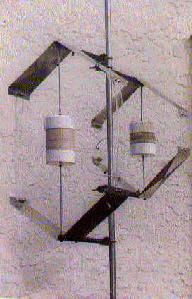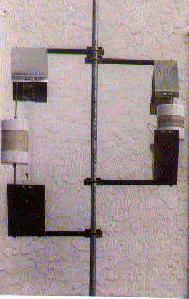Antenna "Isotron" 80/40 COMBO. Encyclopedia of radio electronics and electrical engineering

Encyclopedia of radio electronics and electrical engineering / VHF antennas
 Comments on the article
Comments on the article


Model #80 long, Model #40 short

Antenna "Isotron" 80/40 COMBO


Model #20 in front, #10 on the right. Model #10 front, #15 right
Publication: N. Bolshakov, rf.atnn.ru
 See other articles Section VHF antennas.
See other articles Section VHF antennas.
 Read and write useful comments on this article.
Read and write useful comments on this article.
<< Back
 Latest news of science and technology, new electronics:
Latest news of science and technology, new electronics:
A New Way to Control and Manipulate Optical Signals
05.05.2024
The modern world of science and technology is developing rapidly, and every day new methods and technologies appear that open up new prospects for us in various fields. One such innovation is the development by German scientists of a new way to control optical signals, which could lead to significant progress in the field of photonics. Recent research has allowed German scientists to create a tunable waveplate inside a fused silica waveguide. This method, based on the use of a liquid crystal layer, allows one to effectively change the polarization of light passing through a waveguide. This technological breakthrough opens up new prospects for the development of compact and efficient photonic devices capable of processing large volumes of data. The electro-optical control of polarization provided by the new method could provide the basis for a new class of integrated photonic devices. This opens up great opportunities for ... >>
Primium Seneca keyboard
05.05.2024
Keyboards are an integral part of our daily computer work. However, one of the main problems that users face is noise, especially in the case of premium models. But with the new Seneca keyboard from Norbauer & Co, that may change. Seneca is not just a keyboard, it is the result of five years of development work to create the ideal device. Every aspect of this keyboard, from acoustic properties to mechanical characteristics, has been carefully considered and balanced. One of the key features of Seneca is its silent stabilizers, which solve the noise problem common to many keyboards. In addition, the keyboard supports various key widths, making it convenient for any user. Although Seneca is not yet available for purchase, it is scheduled for release in late summer. Norbauer & Co's Seneca represents new standards in keyboard design. Her ... >>
The world's tallest astronomical observatory opened
04.05.2024
Exploring space and its mysteries is a task that attracts the attention of astronomers from all over the world. In the fresh air of the high mountains, far from city light pollution, the stars and planets reveal their secrets with greater clarity. A new page is opening in the history of astronomy with the opening of the world's highest astronomical observatory - the Atacama Observatory of the University of Tokyo. The Atacama Observatory, located at an altitude of 5640 meters above sea level, opens up new opportunities for astronomers in the study of space. This site has become the highest location for a ground-based telescope, providing researchers with a unique tool for studying infrared waves in the Universe. Although the high altitude location provides clearer skies and less interference from the atmosphere, building an observatory on a high mountain poses enormous difficulties and challenges. However, despite the difficulties, the new observatory opens up broad research prospects for astronomers. ... >>
 Random news from the Archive Random news from the Archive Nanofluid for oil production
21.09.2020
Researchers at the University of Houston have demonstrated that low-cost and non-toxic nanofluids can be used to efficiently extract even heavy, highly viscous oil from reservoirs.
So-called heavy oil - the result of the molecular structure of oil - makes up 70% of the world's oil reserves and will be needed to meet growing energy demands until clean energy sources are developed and used everywhere. Modern oil extraction technologies using steam are expensive and damaging to the environment.
However, scientists have developed a nanofluid that helps to extract oil from the reservoir using the following mechanisms.
The chemical reaction that occurs when the sodium nanoparticles come into contact with the water in the reservoir generates heat, acting in the same way as steam injection and other heat-based methods to push oil out of the reservoir, without the need for external - and greenhouse gas - producing - heat source.
The nanofluid also reacts to form sodium hydroxide, a chemical commonly used in alkaline flooding in oil fields. Sodium hydroxide can cause movement in the oil and cause a viscosity-lowering reaction.
The third reaction produces hydrogen gas that can be used for waterflooding, another common oil recovery method.
The sodium nanomaterials are dispersed after the reaction, thus not damaging the environment. Optimal concentrations will vary depending on individual development conditions.
Sodium is highly reactive with water. This suggests that it may be useful for enhanced oil recovery. However, this also complicates its preparation - exposing it to water too early will result in failure. The researchers solved this problem by preparing sodium nanoparticles in silicone oil, allowing the substance to disperse throughout the tank before it comes into contact with the water in the tank, causing fewer chemical reactions over a larger area. It is also possible to disperse sodium nanoparticles in other solvents, including pentane and kerosene, or even blend them with polymers or surfactants to achieve higher oil recovery.
While the paper focuses on using the nanofluid to increase heavy oil recovery, the scientists note that it could also be used in light oil production and for more general domestic purposes such as cleaning pipes clogged with grease.
|
 Other interesting news:
Other interesting news:
▪ Non-alcoholic beer is good for the heart
▪ Propolis reduces blood pressure
▪ Biofuel for aircraft
▪ Laser cooler for electronics
▪ Apples won't turn brown
 News feed of science and technology, new electronics
News feed of science and technology, new electronics
 Interesting materials of the Free Technical Library:
Interesting materials of the Free Technical Library:
▪ section of the site Grounding and grounding. Selection of articles
▪ article They want to show their education. Popular expression
▪ article Why European navigators before 1473 were afraid to approach the equator? Detailed answer
▪ article Timber road train driver. Standard instruction on labor protection
▪ article An effective antenna for five bands. Encyclopedia of radio electronics and electrical engineering
▪ article Simple quartz filter. Encyclopedia of radio electronics and electrical engineering
 Leave your comment on this article:
Leave your comment on this article:
 All languages of this page
All languages of this page
Home page | Library | Articles | Website map | Site Reviews

www.diagram.com.ua
2000-2024







 Arabic
Arabic Bengali
Bengali Chinese
Chinese English
English French
French German
German Hebrew
Hebrew Hindi
Hindi Italian
Italian Japanese
Japanese Korean
Korean Malay
Malay Polish
Polish Portuguese
Portuguese Spanish
Spanish Turkish
Turkish Ukrainian
Ukrainian Vietnamese
Vietnamese





 Leave your comment on this article:
Leave your comment on this article: